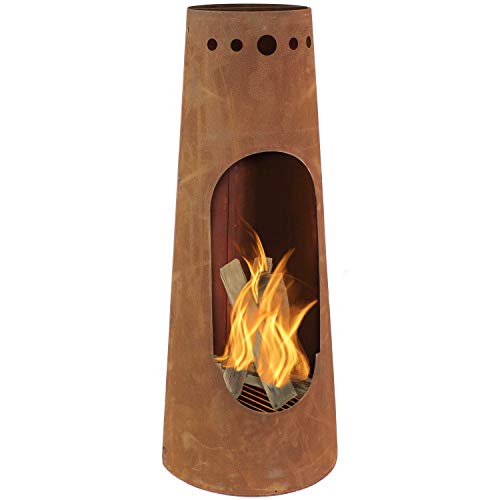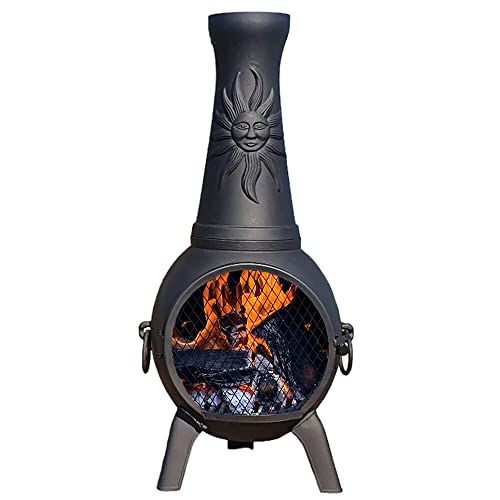5 Laws Everyone Working In Chimineas And Fire Pits Should Know
페이지 정보

본문
 Choosing Between Chimineas and Fire Pits
Choosing Between Chimineas and Fire PitsThe decision between a chiminea and a fire pit will depend on your personal preferences in aesthetics as well as the overall layout of your garden. Chimineas are an elegant design that can complement Rustic 6-Foot Mexican Steel Chiminea for Outdoors outdoor decor. Fire pits are on contrary, have modern lines and can be incorporated with modern garden designs.
Fire pits must be kept away from flammable material for safety reasons. Chimineas can also be used to cook and are more secure in windy environments because of their enclosed design.
Aesthetics
Both chimineas as well as fire pits can add warmth to any outdoor space. However, www.fireplacesandstove.com deciding on the best one depends on your aesthetic preferences and space requirements. Fire pits are more flexible in design than chimineas, but they have additional costs like maintenance and fuel. Chimineas, on the other hand, offer a more traditional look with controlled heat and smoke. Selecting the best American made fire pit or chiminea begins by understanding the differences between the two options and evaluating your requirements.
Chimineas, also called front-loading outdoor ovens, also known as fireplaces are freestanding and have an air vent that is vertical. They are usually constructed of clay or terracotta but are also available in metal, cast iron, or steel varieties. Chimineas made of clay can be decorative and more traditional, but are fragile. Metal versions can withstand higher heat temperatures and are more robust.
The unique design of the chiminea draws smoke upwards, away from the people who are sitting around it. This is a great choice for small spaces where a good way to manage smoke is essential. They are also easy to clean because they have an open top, and can be used with a grill to cook. cooking. They are also safer than fire pits because they don't create the same amount of sparks.
Fire pits, on other hand are designed to permit the full combustion of wood. They can also be used with different fuel types. They are a popular choice for outdoor patios and can be positioned close to seating areas. They can burn logs of any size, and twigs as well as small branches to produce more controlled flames.
When deciding between a firepit or a chiminea, the initial investment and the ongoing costs are important factors to consider. Chimines may cost more initially, but its durability and ease-of-use can reduce long-term costs. On the other the other hand, a fire pit might be less expensive but will require more frequent maintenance and replacement parts. In addition, a chiminea could have a lower environmental impact with its controlled burn and less smoke, whereas a fire pit can generate more smoke and emissions.
Heat output
The amount of heat generated by a chiminea depends on its size, the type of wood it uses and the manner in which it is placed in the fire. Dry, seasoned wood will produce more heat than damp or green wood. A chiminea in a good location, not shaded by trees or other structures will also receive more heat than one that is. The chiminea's chimney can also help in directing heat to the air, particularly when funnel designs are used.
The feeling of warmth is different for each. The type of clothing being worn, the personal metabolism of each person, and other factors in the body affect how warm a person feels. Despite these factors they are still a fantastic source of heat for small groups or intimate gatherings.
Chimineas have a large base and an open chimney that draws in air to fuel the flames. They are available in terracotta, clay, or cast iron, however the ones made of metal are more resistant to rust and can withstand high temperatures. Clay and terracotta models have an older-style appearance but they can break down over time and require a special treatment. Cast iron models are more robust and are suitable for cooking food. They also have the capacity to hold larger logs.
Apart from being a stunning decorative element in addition to being a great feature for your home, these units are excellent for heating outdoor spaces. They can be set up on the patio or in the backyard to create a cozy environment. Many homeowners combine a chiminea and a grill to improve their cooking capacity.
In contrast to fire pits, fire pits have a narrower opening to the body, which limits the size of the logs you can use. These units are also more likely to generate many sparks, so they must be kept in a secure place. In general the fire pit is ideal for large outdoor spaces in which there are many people who would appreciate its warmth when the sun goes down.
Smoke control
A chiminea can help you create a comfortable space for friends and family to gather, whether it's to give a rustic appearance to your backyard or patio. These beautiful fireplaces, which were originally used for heating and cooking, come in a range of materials. Traditional clay models as well as modern cast iron models are available. They are best placed close to the ground and feature an open flame design which draws in oxygen to ignite, while keeping the flames away from the people.
Chimineas radiate heat outwards from the front opening to warm people who are seated near them. However the chimney stack may be quite low and therefore produce a lot of wood smoke, especially when burning wood that isn't fully dried. Carbon monoxide, a colourless and odourless gas, may accumulate if the wood are not fully seasoned. This can be avoided by using seasoned hardwood, or alternative fuels such as bioethanol.
Fire pits, on the other hand, are open on all sides which allows the heat they produce to be felt by all within a 360-degree circle. However, they may produce a significant amount of smoke, based on the direction of the wind and the size of the logs used. This can be avoided by choosing the model with double wall construction that improves airflow and reduces smoke emissions.
Both chimineas and fire pits require regular maintenance to ensure they function safely. Assess your priorities to select the best option for your outdoor living space. Consider safety, maintenance requirements, and the impact on the environment. Choose a chiminea that complies with local laws and regulations regarding outdoor fires. Also, choose eco-friendly fuel options to minimize environmental impacts.
In terms of safety, chimineas are typically safer than fire pits as they contain the flame and direct upwards. They are more stable than firepits because they are on a stand rather than directly on the ground. However it is important to keep them away from flammable objects like fences and sheds. They still release smoke and sparks that may cause a blaze in seating areas. Make sure to use spark screens if you're in a position near one.
Maintenance
Chimineas, especially clay models, require careful care due to their brittleness. They should be placed on a level surface and it is crucial to keep pets and children at a safe distance to avoid accidents. It is important to keep the chiminea safe from any flammable structure or objects. The body may remain hot for a long time after it's been lit. Be careful not to extinguish the fire by using water, as this could cause the material to crack or break. A fire pit made of strong materials such as metal is recommended, as it can withstand a greater degree of heat and is less likely to be damaged by rain or snow.
Both kinds of outdoor fire pits can be an attractive focal point for any backyard or patio. Chimineas are a better option for a rustic look, fire pits can be used with various designs for gardens and homes. When choosing between these two options, consider personal aesthetic preferences, maintenance capabilities, and environmental concerns.
Based on the materials used, both chimineas and as well as fire pits can be found in various sizes and styles that can be adjusted to any space. Clay chimineas are a great way to showcase a Mexican heritage and steel fire pits are durable and easy to clean. When selecting the best model, consider both the initial cost as well as the long-term costs of each.
While both types of outdoor fireplaces produce smoke and emissions Chimineas are less controlled in the production of their emissions which reduces health risks and nuisances to neighbours. The fuel choices play a crucial part in this, and seasoned wood is preferable for a lower smoke output.
Chimineas also provide an easier experience for guests to entertain, due to their enclosed design and chimney stacks direct smoke upward to prevent inhalation. A fire pit, on the other hand, is more open and exposed to winds, which can increase the amount of smoke generated. Both are eco-friendly if they make the right fuel choice However, chimineas are better equipped to minimize the environmental impact than fire pits.

- 이전글5 Glass Hinge Projects That Work For Any Budget 24.09.19
- 다음글You'll Never Be Able To Figure Out This Travel Infant Car Seat's Benefits 24.09.19
댓글목록
등록된 댓글이 없습니다.